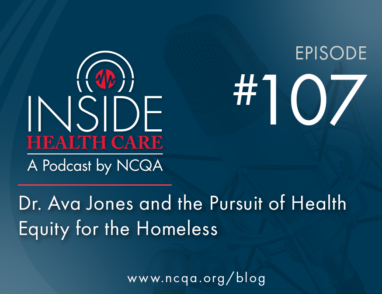Register for PCMH Redesign Hangout Wednesday; Read Recap on Growing Support
February 22, 2016 · Shireesha Jevaji
For the past year, NCQA has been planning an ambitious redesign of PCMH Recognition, in response to feedback from clinicians, practices, employers, payers, health services researchers and other key stakeholders. We recently completed two pilots of the revised program, involving more than 120 practices across 15+ states and a variety (e.g., size, geography, ownership) of primary care practices.
Please join us on February 24 at 2 pm ET for the PCMH Recognition Redesign Pilot Google Hangout, for a quick update on our progress and to hear from three PCMH practices that participated in the redesign pilot.
Last year, NCQA posted evidence from a study that highlighted quickly growing support for patient-centered medical homes. Our Growing Support for PCMH Hangout gave our audience three key takeaway ideas:
- Ongoing adequate financial support is essential for both payers and patients to see a significant return on investment and to get the benefits that PCMHs provide.
- PCMHs have the potential to meet behavioral health challenges by integrating behavioral care into their practices.
- PCMH incentives consider not only the cost of the PCMH model, but also the value and savings that PCMHs provide to the entire health system.
We answered questions during our live Google Hangout, and compiled our top 10 Q&As about content, resources and challenges facing Patient-Centered Medical Homes.
Q: How do you define “medical home”? Is there more than one medical home model of care?
A: “Medical home” is a general term that describes a philosophy established in the Joint Principles of the Patient-Centered Medical Home. The model is still evolving—not all medical homes look alike or use the same strategies to reduce costs, improve quality and coordinate care. NCQA Recognition offers distinction and a stamp of approval to those that successfully meet specific standards and requirements.
For practices just beginning the journey of PCMH transformation, NCQA’s program highlights the key functions of the medical home by indicating specific elements as “must pass.” These are required to achieve any level of recognition, so they are a great starting point to evaluate practice readiness for transformation. For more information about NCQA’s PCMH Recognition Program, visit our Web site to download the publication.
Q: How does PCMH recognition fit with other requirements (e.g., Meaningful Use, PQRS) and programs (e.g., ACO)?
A: Because practices have many reporting requirements, NCQA aligned PCMH requirements with Meaningful Use (MU), to enable practices to use MU reports to meet PCMH factors, where appropriate.
Practices submitting clinical quality measures for MU or PQRS may also use those measures to submit data for PCMH standard 6, which focuses on quality improvement. The standard’s requirements specify measure categories, but do not require a particular set of measures. This approach allows practices to submit data for measures they already collect to address care needs of their patient populations.
The PCMH model sets a foundation for practices to be part of programs that reward accountability, quality and cost savings. Programs such as ACO require that practices function in a patient-centric manner to monitor population health and to ensure that patients receive appropriate and coordinated care. NCQA’s ACO Accreditation program provides automatic credit for certain requirements if the ACO contains a certain percentage of PCMH-recognized sites.
NCQA also strives to reduce practice burden and align with other programs by providing automatic credit for PCMH practices where requirements in other recognition programs overlap, such as PCSP, Diabetes and Heart/Stroke recognition programs. Some primary care societies also offer Maintenance of Certification credit for clinicians participating in PCMH. For practices using a prevalidated HIT solution, NCQA offers automatic credit to help them leverage established technologies that align with PCMH requirements.
Q: For small practices that may have limited access to resources, what are the best ways to integrate providers, such as behavioral healthcare, and pharmacists into the practice?
A: Practices do not need to add providers or pharmacists to their practice to function as a PCMH. While these resources may be helpful to have on site, integration is more about partnerships and better care coordination than about employing additional care team members. For example, integration could be accomplished by establishing a relationship with a behavioral healthcare provider who can (at least partially) access patient medical records. Practices can also work closely with specialists, pharmacists and other community groups to broaden their resource pool. These types of relationships bolster care coordination and enable even smaller practices to offer continuity of care.
Q: It can be difficult to get patients engaged in care, particularly outside the office. What are best practices for patient engagement?
A: This is a big challenge in health care today. With competing priorities in life, many patients can’t focus on or prioritize treatment goals to improve their condition between visits. NCQA PCMH Recognition strives to help this issue by incorporating patients’ preferences and personal goals in the medical record, as an effort to prompt meaningful discussions about treatment plans. If a practice can focus patients on personal goals and help them see how treatment can enable them to reach those goals, patients can engage. For example, an arthritic patient may improve adherence to medication and a physical activity regimen if he reframes the treatment goals to focus on his desire to walk his daughter down the aisle at her wedding.
The program also emphasizes training staff to teach self-management techniques and provide patients with self-management tools and resources, to help them manage conditions over time.
Q: Where do you see PCMH in the next 3–5 years?
A: In 2017 NCQA will launch a redesigned PCMH recognition process, designed to reduce the documentation burden and encourage the sustainability necessary to truly transform into a medical home. New practices will have the opportunity for a tailored submission experience, guided by a navigator. Virtual evaluations will let practices demonstrate their capabilities and processes to reviewers, to achieve credit on the PCMH survey.
Practices that have earned recognition will move to a process of annual submission of a specific set of data. The pilots for these processes are still in progress. For more information, read Dr. Michael Barr’s blog post from June 2015, addressing the redesign.
NCQA offers recorded and live training and Q&A sessions each month, or you can submit questions online using the Policy Clarification System.
Q: Has the bar been raised so high that many offices are defeated before they ever get started?
A: This can be an issue for many small practices with limited resources. The key is understanding that PCMH is not a destination, but a model of care. If the bar is set high—as with any goal—the best way to hurtle it is to start with what you have and make improvements today—even focusing on using staff to the fullest extent of their license and beginning to align workflow, policies and procedures, puts a practice in a better position to demonstrate its commitment to ongoing quality improvement.
There are a number of nationwide PCMH recognition and accreditation programs. NCQA’s PCMH Recognition program, developed to mirror priorities outlined in the Joint Principles, provides a specific set of standards designed to the transformation into a medical home. It outlines core functions and processes that must be established and carried out consistently by an engaged care team. Transforming into a PCMH is an investment and requires a great deal of change for a practice. Leadership and staff buy-in and culture change are crucial aspects to true transformation. But although it’s a lot of work, there is evidence that embracing this model provides better quality of care and lowers costs.
Becoming a PCMH is not complete when a practice achieves recognition; being a medical home is a journey that requires consistent evaluation and quality improvement to ensure patients receive safe, evidence-based and coordinated care that considers their preferences and priorities.
Q: How do practices transform and sustain if they lack resources and financial incentives?
A: NCQA emphasizes collaboration. It is important to consider models that pool resources in communities that may not have as many available (e.g., rural practices). Even if they use a regional HIE, a network of care managers and telehealth services, communities have a number of environmental and economic challenges, as well as issues of supply and demand. Financial support is critical, but collaboration has proven to help innovation.
Limited financial and human resource support, as well as a lack of buy-in at the leadership level, is often due to competing priorities. As employers, payers and systems continue to see the benefits of using a standardized baseline model for delivering high-quality care improving quality across care settings, we believe that the number of payers and health care institutions funding transformation will grow.
Q: How are practices integrating case managers into their practice teams?
A: PCMHs are not only charged with delivering high-quality, evidence-based primary care services; they must also identify high-risk populations and ways to reduce duplicate services and ED visits, ensure access to needed community resources and engage patients as partners in their own care. While dedicated case managers, coordinators and navigators supporting both practice and patient in achieving these objectives is a great benefit, they are not required for a practice to accomplish the goal of managing population health.
Many innovative models are being explored for allocating care management activities in the medical home. PCMH standards are not prescriptive—NCQA understands that every practice is different and works with varying human resources. We have seen a number of Level 3 practices successfully use MAs to administrate care management activities, and we believe it is not the title of the position that affects clinical outcomes, as much as it is the quality of work associated with executing assigned activities. Leveraging staff this way can reduce turnover and increase satisfaction.
Q: How do you get “buy in” from providers, physicians and nurse practitioners who are already overworked and overstressed?
A: Communicating the goals of the Triple Aim to the entire care team is critical. Reducing costs and improving clinical outcomes for high-risk populations is important, but the goal of preventing patients from becoming part of high-risk populations is equally important. The basis of the PCMH model is improving patient care and organizing the care team to ultimately make it more efficient. Transforming into a PCMH requires a significant investment up front, but the downstream benefits are significant. Evidence shows that instituting the PCMH model reduces provider and staff burn-out through defined roles and responsibilities that enable staff to work at the top of their licenses. Communicating the short-term and the long-term goals of transformation could be beneficial for engaging staff and helping them understand the “why” and the importance of having a strong wellness model within the medical home.
Q: How can we solve the challenge of data transfer when providers are using multiple, disparate EMR systems?
A: Interoperability is a challenge, and many recognized practices are collaborating with their referral networks to identify ways to exchange data, whether through regional HIEs or by secure fax. The requirements of the PCMH 2014 standards and guidelines encourage innovation, collaboration and collective steps to improved integration, and are also realistic about the challenges practices face and what they can accomplish at any given point.









